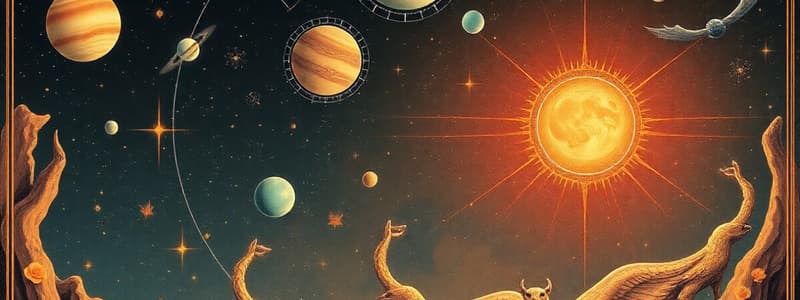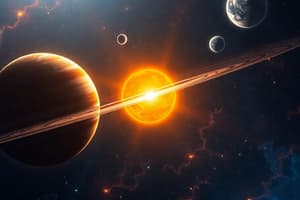Podcast
Questions and Answers
What percentage of the solar system's mass is contained in the Sun?
What percentage of the solar system's mass is contained in the Sun?
- 100%
- 50%
- 99% (correct)
- 75%
Which of the following is NOT considered a characteristic of the inner planets?
Which of the following is NOT considered a characteristic of the inner planets?
- Smaller in size
- Have many moons (correct)
- Tend to spin slower on their axis
- Primarily composed of rock and metal
What is one of the major differences between inner and outer planets?
What is one of the major differences between inner and outer planets?
- Outer planets have rings consisting of ice and dust (correct)
- Outer planets are predominantly made of metal
- Inner planets are larger than outer planets
- Inner planets spin faster
Which of the following celestial bodies is classified as an outer planet?
Which of the following celestial bodies is classified as an outer planet?
What event caused Pluto to lose its status as a planet?
What event caused Pluto to lose its status as a planet?
What is the approximate mean radius of Earth?
What is the approximate mean radius of Earth?
Which of the following best describes the structure of the Milky Way?
Which of the following best describes the structure of the Milky Way?
What does one Astronomical Unit (AU) represent?
What does one Astronomical Unit (AU) represent?
Which characteristic is NOT true about the outer planets compared to the inner planets?
Which characteristic is NOT true about the outer planets compared to the inner planets?
What defines the group of celestial objects classified as galaxies?
What defines the group of celestial objects classified as galaxies?
Flashcards
Solar System
Solar System
The Sun and all objects (planets, moons, rocks, ice, dust) traveling around it.
Milky Way
Milky Way
A disc-shaped galaxy containing our Solar System.
Galaxy
Galaxy
A large group of stars held together by gravity.
Inner Planet
Inner Planet
Signup and view all the flashcards
Outer Planet
Outer Planet
Signup and view all the flashcards
Astronomical Unit (AU)
Astronomical Unit (AU)
Signup and view all the flashcards
Planet
Planet
Signup and view all the flashcards
Terrestrial Planet
Terrestrial Planet
Signup and view all the flashcards
Jovian Planet
Jovian Planet
Signup and view all the flashcards
Earth's Shape
Earth's Shape
Signup and view all the flashcards
Study Notes
Our Solar System
- Composed of the Sun and all objects orbiting it, including planets, moons, rocks, ice, and dust.
- Located near the edge of the Milky Way galaxy.
- The Milky Way galaxy is a large, disc-shaped group of stars held together by gravity.
- Galaxies are made up of stars of different sizes, shapes, and densities.
- The Sun accounts for 99% of the solar system's mass.
- One Astronomical Unit (AU) is the average distance from Earth to the Sun, approximately 150 million kilometers.
Planets
- Large, spherical objects that orbit a specific area.
- Rotate on their own axis.
- Inner planets (terrestrial planets):
- Primarily composed of rock and metal.
- Smaller compared to outer planets.
- Either have no moons or one or two.
- Rotate relatively slowly on their axis.
- Examples: Mercury, Venus, Earth, Mars
- Outer planets (Jovian or Gas Giants):
- Primarily composed of hydrogen and helium.
- Larger than inner planets.
- Many moons.
- Rings made of rock and dust.
- Examples: Jupiter, Saturn, Uranus, Neptune
- Mercury and Venus do not have moons.
- Pluto was reclassified as a dwarf planet in 2006.
Earth
- Shape: Spheroid-shaped, slightly flattened at the poles and bulging at the equator (for mathematical purposes, an ellipsoid is used).
- Mean radius: 6,371 km
- Circumference at the equator: 40,075 km
Studying That Suits You
Use AI to generate personalized quizzes and flashcards to suit your learning preferences.




